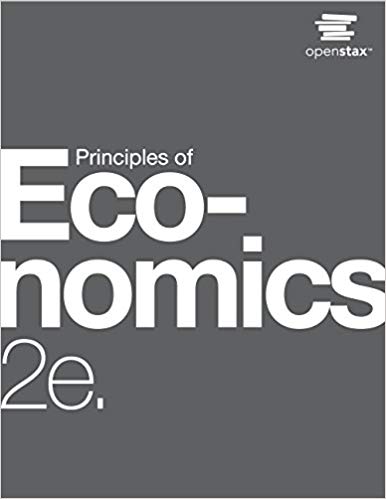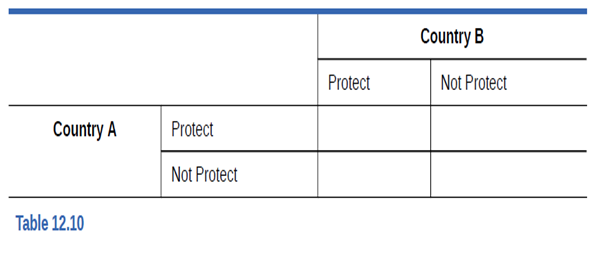
Consider the case of global environmental problems that spill across international borders as a prisoner’s dilemma of the sort studied in
- In Table 12.10, fill in the costs, benefits, and total payoffs to the countries of the following decisions. Explain why, without some international agreement, they are likely to end up with neither country acting to protect the environment.

Trending nowThis is a popular solution!

Chapter 12 Solutions
Principles of Economics 2e
Additional Business Textbook Solutions
Construction Accounting And Financial Management (4th Edition)
Horngren's Cost Accounting: A Managerial Emphasis (16th Edition)
Financial Accounting (12th Edition) (What's New in Accounting)
Principles of Management
Cost Accounting (15th Edition)
Principles of Accounting Volume 2
- Two US states, New California and North Arizona, are negotiating over the distribution of water from a river. Assume the total amount of the river is 100, and each state wants as much as possible. The river starts in North Arizona, so they make an offer to New California about how to divide the river. New California can accept or reject the offer. They can also ask the federal government to decide the issue. Both states expect that the federal government would give New California 60% of the waters and North Arizona the remainder. However, the delay of asking the federal government to decide the issue would cost each state utility worth 5% of the river waters. Draw a bargaining game to represent this situation. Solve the game to find its subgame perfect Nash equilibrium. How much water would each state get?arrow_forwardsuppose that the world is comprised of two countries: X and Y. Because of the absence of centralized world governance, the control of global externalities is particularly challenging, which is the case with greenhouse gases linked to climate change. The entries in the following Payoff Table describe each country's well-being under different abatement patterns: X\Y No Abate Abate No Abate 12,12 24,8 Abate 8,24 20,20 Now suppose that the game is repeated indefinitely. Define the concepts of Trigger Strategies and also the concept of Business as Usual Strategies for the repeated game. Verify that trigger strategies supporting cooperative payoffs (20,20) constitute a non-cooperative equilibrium of the repeated game when δ=0.8. Are trigger strategies still an equilibrium when δ=0.30? Explain intuitively why and verify that Business as Usual still is an equilibrium in this case.arrow_forwardTable 17-1 Imagine a small town in which only two residents, Celia and Venya, own wells that produce safe drinking water. Each week Celia and Venya work together to decide how many gallons of water to pump. They bring the water to town and sell it at whatever price the market will bear. To keep things simple, suppose that Celia and Venya can pump as much water as they want without cost so that the marginal cost of water equals zero. The town's weekly demand schedule and total revenue schedule for water is shown in the following table: Quantity Price Total Revenue and Total Profit (Gallons) (Dollars per gallon) (Dollars) 36 33 30 27 24 21 40 1,320 2,400 3.240 3,840 4,200 4,320 4,200 3,840 3,240 2,400 1,320 80 120 160 200 240 18 280 15 320 12 360 400 6. 3 440 480 Refer to Table 17-1. Suppose the town enacts new antitrust laws that prohibit Celia and Venya from operating as a monopoly. What will be the price of water once Celia and Venya reach a Nash equilibrium? O a. $12 O b. $15 O. $9 O…arrow_forward
- Table 17-1 Imagine a small town in which only two residents, Celia and Venya, own wells that produce safe drinking water. Each week Celia and Venya work together to decide how many gallons of water to pump. They bring the water to town and sell it at whatever price the market will bear. To keep things simple, suppose that Celia and Venya can pump as much water as they want without cost so that the marginal cost of water equals zero. The town's weekly demand schedule and total revenue schedule for water is shown in the following table: Price Quantity Total Revenue and Total Profit (Gallons) (Dollars per gallon) (Dollars) 36 40 33 1,320 2,400 3,240 3,840 4,200 80 30 120 27 160 24 200 21 240 18 4,320 4,200 280 15 3,840 3,240 2,400 320 12 360 9 400 440 3. 1,320 480 Refer to Table 17-1. If Celia and Venya operate as a profit-maximizing monopoly in the market for water, how many gallons of water will be produced and sold? O a. 240 O b. 280 OC 480 Od.0arrow_forwardTable 17-1 Imagine a small town in which only two residents, Celia and Venya, own wells that produce safe drinking water. Each week Celia and Venya work together to decide how many gallons of water to pump. They bring the water to town and sell it at whatever price the market will bear. To keep things simple, suppose that Celia and Venya can pump as much water as they want without cost so that the marginal cost of water equals zero. The town's weekly demand schedule and total revenue schedule for water is shown in the following table: Quantity (Gallons) 0 40 80 120 160 200 240 280 320 360 400 440 480 Price (Dollars per gallon) 36 33 c. 0 gallons d. 240 gallons 30 27 24 21 18 15 12 9630 Total Revenue and Total Profit (Dollars) 0 1,3201 2,400 3,240 3,840 4,200 4,320 4,200 3,840 3,240 2,400 1,320 0 Refer to Table 17-1. What is the socially efficient quantity of water? Ⓒa. 280 gallons b. 480 gallonsarrow_forwardSuppose that the world is comprised of two countries: X and Y. Because of the absence of centralized world governance, the control of global externalities is particularly challenging, which is the case with greenhouse gases linked to climate change. The entries in the following Payoff Table describe each country's well-being under different abatement patterns: If both countries were able to enforce a binding agreement, they would agree on an efficient arrangement (or strategy profile) that also is equitable. We will refer to such arrangement as a cooperative solution. However, absent an appropriate global enforcement mechanism, they would engage in non-cooperative behavior. Define the appropriate concepts of Efficiency and (non-cooperative) equilibrium, find the equilibrium and verify that it is not efficient in the context of a static strategic game in which both countries select their abatement levels simultaneously. Taking into account the common resource nature of the problem,…arrow_forward
- ASAParrow_forwardImagine an Island a short distance off the east coast of a country. This island is called Onus, and it has a population of about 500 residents. Their only way to the mainland is by the ONE ferry boat that runs between Onus and the mainland (the ferry operates as a monopoly). Similarly, a short distance off the west coast of the same country is another island, Yuri, with a similar population of about 500 residents. Yuri, however, is a tourist attraction. There are MANY ferry boats running between Yuri and the mainland (each ferry operating in this perfectly competitive market). Each Yuri ferry operator provides service to both the tourists and to the 500 west coast island residents. Using the information that you learned in Chapter 13 of the text, answer the following questions by comparing and contrasting the differences between the monopoly market in Onus and the perfectly competitive market in Yuri. Explain in detail what differences in demand that the monopoly ferry…arrow_forwardImagine an Island a short distance off the east coast of a country. This island is called Onus, and it has a population of about 500 residents. Their only way to the mainland is by the ONE ferry boat that runs between Onus and the mainland (the ferry operates as a monopoly). Similarly, a short distance off the west coast of the same country is another island, Yuri, with a similar population of about 500 residents. Yuri, however, is a tourist attraction. There are MANY ferry boats running between Yuri and the mainland (each ferry operating in this perfectly competitive market). Each Yuri ferry operator provides service to both the tourists and to the 500 west coast island residents. Using the information that you learned in Chapter 13 of the text, answer the following questions by comparing and contrasting the differences between the monopoly market in Onus and the perfectly competitive market in Yuri. 1. Explain in detail how the monopoly ferry operator will determine the quantity…arrow_forward
- Imagine an Island a short distance off the east coast of a country. This island is called Onus, and it has a population of about 500 residents. Their only way to the mainland is by the ONE ferry boat that runs between Onus and the mainland (the ferry operates as a monopoly). Similarly, a short distance off the west coast of the same country is another island, Yuri, with a similar population of about 500 residents. Yuri, however, is a tourist attraction. There are MANY ferry boats running between Yuri and the mainland (each ferry operating in this perfectly competitive market). Each Yuri ferry operator provides service to both the tourists and to the 500 west coast island residents. Using the information that you learned in Chapter 13 of the text, answer the following questions by comparing and contrasting the differences between the monopoly market in Onus and the perfectly competitive market in Yuri. 1. Both the Onus ferry operator in the monopoly market and each of the Yuri ferry…arrow_forwardImagine an Island a short distance off the east coast of a country. This island is called Onus, and it has a population of about 500 residents. Their only way to the mainland is by the ONE ferry boat that runs between Onus and the mainland (the ferry operates as a monopoly). Similarly, a short distance off the west coast of the same country is another island, Yuri, with a similar population of about 500 residents. Yuri, however, is a tourist attraction. There are MANY ferry boats running between Yuri and the mainland (each ferry operating in this perfectly competitive market). Each Yuri ferry operator provides service to both the tourists and to the 500 west coast island residents. Using the information that you learned in Chapter 13 of the text, answer the following questions by comparing and contrasting the differences between the monopoly market in Onus and the perfectly competitive market in Yuri. Explain in detail how the monopoly ferry operator in Onus will determine the…arrow_forwardImagine a small town in a remote area where only two residents, Maria and Miguel, own dairies that produce milk that is safe to drink. Each week Maria and Miguel work together to decide how many gallons of milk to produce. They bring milk to town and sell it at whatever price the market will bear. To keep things simple, suppose that Maria and Miguel can produce as much milk as they want without cost so that the marginal cost is zero. The weekly town demand schedule and total revenue schedule for milk is shown in the table below: Quantity (in gallons) 10 |1 O b. $12 O c. $10 d. S8 2 113 14 לן 16 17 18 19 10 11 12 Price $24 $22 $20 $18 $16 $14 $12 $10 $8 $6 $4 $2 $0 Total Revenue (and Total Profit) $0 $22 $40 $54 $64 $70 $72 $70 $64 $54 $40 $22 $0 Refer to Table 17-3. Suppose the town enacts new antitrust laws that prohibit Maria and Miguel from operating as a monopoly. What will be the price of milk once Maria and Miguel reach a Nash equilibrium? a. $14arrow_forward
 Managerial Economics: Applications, Strategies an...EconomicsISBN:9781305506381Author:James R. McGuigan, R. Charles Moyer, Frederick H.deB. HarrisPublisher:Cengage Learning
Managerial Economics: Applications, Strategies an...EconomicsISBN:9781305506381Author:James R. McGuigan, R. Charles Moyer, Frederick H.deB. HarrisPublisher:Cengage Learning
